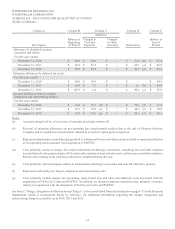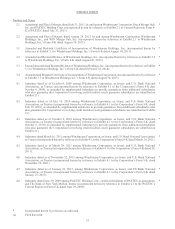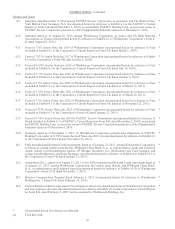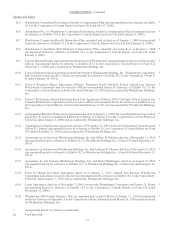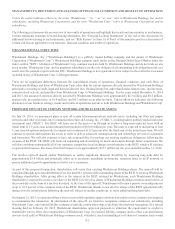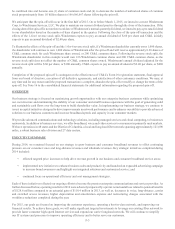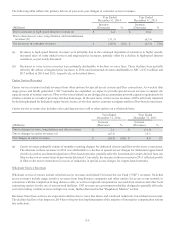Windstream 2014 Annual Report Download - page 120
Download and view the complete annual report
Please find page 120 of the 2014 Windstream annual report below. You can navigate through the pages in the report by either clicking on the pages listed below, or by using the keyword search tool below to find specific information within the annual report.
F-4
BUSINESS TRENDS
The following discussion highlights key trends affecting our business.
Business communications services: Demand for advanced communications services is expected to drive growth in revenues from
business customers. To meet this demand, we continue to expand our capabilities in integrated voice and data services, which
deliver voice and broadband services over a single Internet connection. We also offer multi-site networking services which provide
a fast and private connection between business locations as well as a variety of other data services. We leverage our national
network to offer more complex and customized solutions to our customers. While offering sales growth opportunities, the shift to
more complex solutions requiring additional customization can lead to longer installation times. We view this as a strategic growth
area, but we are subject to competition from other carriers and cable companies, which could suppress growth and result in lower
operating margins. We combat competition by offering personalized service to our business customers through advanced
customized solutions, an integrated sales approach, and dedicated representatives. See “Competition” in Item 1 of Part I of this
Annual Report for more details.
Data center services: Many businesses are moving towards cloud computing and managed services as an alternative to a traditional
information technology (“IT”) infrastructure. Our data centers are capable of delivering those services, and we continue to invest
in data center expansion in order to meet the growing demand for these types of services. In addition to cloud computing and
managed services, our data centers offer colocation services, in which we provide a safe, secure environment for storage of servers
and networking equipment.
Carrier access: As wireless data usage grows, wireless carriers need additional bandwidth on the wireline network to accommodate
the additional wireless traffic. We have made significant success-based capital investments to provide backhaul services to wireless
carriers. These investments include building out fiber to new wireless towers and replacing copper facilities with fiber facilities
to wireless towers we already serve. We will continue to make success-based capital investments to offer additional wireless
backhaul services to wireless carriers; however, these investments decreased substantially during 2014 as we have reached the
vast majority of existing towers within our targeted area. In the near term, carrier access revenues will be adversely impacted by
declining demand for dedicated copper-based circuits, as wireless carriers continue to migrate traffic to fiber-based connections.
Consumer high-speed Internet: As of December 31, 2014, we provided high-speed Internet service to approximately 74 percent
of primary residential lines in service. The number of high-speed Internet customers we serve will continue to be impacted by the
effects of competition from other service providers and increased penetration in the marketplace as the number of households
without high-speed Internet service continues to shrink. As a result, consumer high-speed Internet connections decreased 39,300,
or 3.4 percent during the year ended December 31, 2014, as compared to 43,600, or 3.6 percent, during 2013. To offset the effects
of competition, we believe growing customer demand for faster speeds and value-added services, such as online security and back-
up, will drive growth in consumer high-speed Internet revenues. We continue to focus on increasing our broadband speeds available
to customers. As of December 31, 2014, we could deliver speeds up to 3 Megabits per second (“Mbps”) to all of our addressable
lines, and speeds up to 6 Mbps, 12 Mbps and 24 Mbps are available to approximately 80 percent, 54 percent and 18 percent of
our addressable lines, respectively.
Consumer voice line losses: Voice and switched access revenues will continue to be adversely impacted by future declines in voice
lines due to competition from cable companies, wireless carriers and providers using other emerging technologies. To combat
competitive pressures, we continue to emphasize our bundled products and services. Our consumers can bundle voice, high-speed
Internet and video services, providing one convenient billing solution and bundle discounts. We believe that product bundles
positively impact customer retention, and the associated discounts provide our customers the best value for their communications
and entertainment needs. As of December 31, 2014, all of our voice lines had wireless competition and approximately 70 percent
of our voice lines had fixed-line voice competition.
Operational efficiencies: To secure our bottom line against evolving revenue streams and a shift in our revenue mix that has resulted
in a higher proportion of lower margin revenues, we are committed to aggressive cost management strategies that emphasize
operational efficiencies. During 2014, we completed two workforce reductions to increase operational efficiency by eliminating
a total of approximately 750 positions, including 295 resulting from voluntary separation initiatives. We anticipate annualized
savings of approximately $40 million as a result of streamlining our workforce. During 2015, we will remain focused on
improvements in our cost structure through network grooming and continued declines in the cost of providing services resulting
from operational efficiencies and billing system conversions that will further reduce costs.


